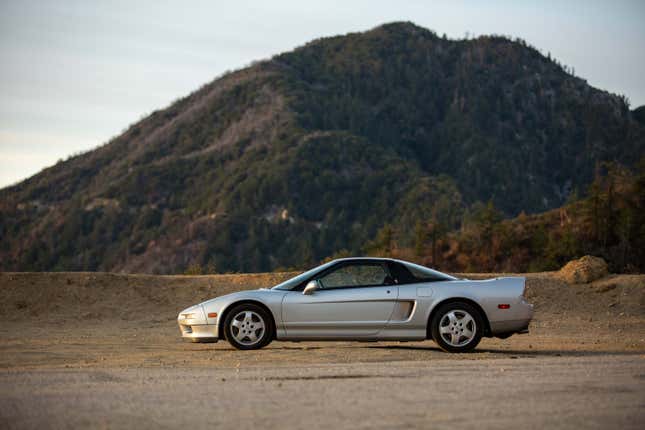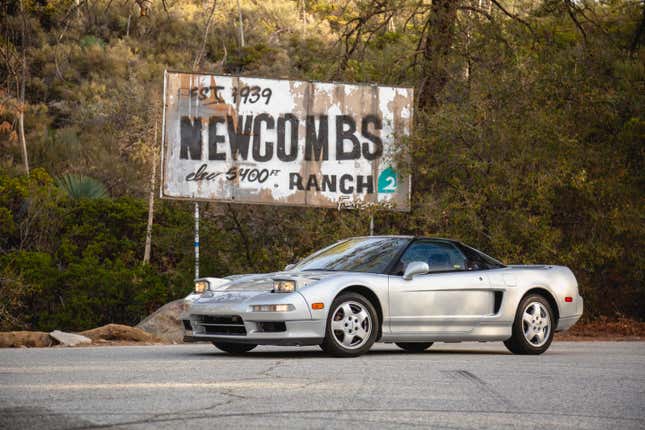Honda’s New Sports eXperimental absolutely changed the game when it debuted in 1990. It was a beautiful and exotic shape from a company better known for economy cars, with the performance to match. The engineering was so faultless that it dunked on mainstay exotics from Ferrari, Porsche, and Lotus for twenty to forty thousand fewer dollars. There’s a reason it was lauded as the height of automotive engineering at the time and has continued to earn respect from everyone to drive it since.
For me, the NA1-generation NSX might be the pinnacle of automotive driving experience achievement, besting everything before it and everything since.
Full Disclosure: Acura handed me the keys to its very own early NSX for a week while I was in Los Angeles for Radwood SoCal. I drove down with a big van loaded with supplies for the show, and didn’t want to drive that around the traffic-laden city all week. Acura was the title sponsor of the event, the American Honda campus played the part of event venue, and I am a co-founder of Radwood. I drove the car into the show on Saturday and returned it in the same condition.

Three-thousand pounds, 270 horses, 5 speeds, two seats. Honest to God, what else could you possibly want? By modern standards the NSX isn’t setting the world on fire with acceleration, sprinting from 0-60 in 5.2 seconds and tripping the quarter in 13.8, but shit it doesn’t feel slow. For decades dozens of companies all over the world have been trying to build the perfect sports car, but Acura did it way back in 1990.
I recently drove a Porsche 911 that was more comfortable than the NSX, it was more powerful than the NSX, it was way quicker, had a higher top speed, and delivered peak lateral acceleration of 1.4 Gs as compared to the NSX’s claimed 0.86. But it wasn’t more fun.

Sports cars have always been a game of numbers, but the numbers simply cannot tell the whole story. You can’t decipher perfect balance from a spec sheet, or comprehend the delicacy and directness of an unassisted steering rack. A number can tell you how quickly a car lapped the the Nürburgring, for example, but not the size of the driver’s smile.

Despite the heavy weekday traffic and horrible roads of the greater Los Angeles area, the NSX was truly a joy to live with. This is a car that was designed from the outset with daily usability in mind, and while speed was always a part of the puzzle, comfort and compliance were clearly at the fore. Fit and finish were standard 90s Honda fare, which is to say good but a little cheap.
This particular example has seen better days, as it was recently returned to the Honda/Acura brand after a few decades out mingling with the public. With the odometer sitting around 60,000 miles, it was well broken in. The left driver’s seat bolster was worn away from thousands of hops in and crawls out, the windshield trim was kinked at the passenger’s A-pillar, causing undue wind whistle, and the factory radio was bunk — a common issue with these cars — so it was fitted with an aftermarket bluetooth connection behind stock controls. The only change from stock, as near as I could tell, was the fitment of a set of modern sticky Dunlop tires.

Standing at 6'1" I was never going to be an easy fit in the low cockpit of the NSX. Legroom was never an issue, as the seat could go much farther back than I needed it to. I was, however, forced to slouch significantly in the seat to avoid constantly bouncing my head into the roof. The one thing I would change about an NSX to fit my own life is a thinner seat or lower mounting bracket. Or maybe a Gurney bubble. It’s worth it. This was the everyday Ferrari before Ferraris could be driven every day. Would that I were a few inches shorter. Would that it were so simple.

In spite of my height, I still found myself aching for excuses to climb behind the wheel of the NSX. In exchange for the labor of forcing an arc in my spine, I was rewarded with the most pure and delightfully engaging driving experience of my life. Every notch of the shifter or forceful tug at the steering wheel, dab of clutch, brush of brake, or bootful of throttle was met with analog response. The car bends to you whims, as there’s nothing separating you from the drive. No messy computers or artificial intelligence to filter your inputs through. Whatever you do, the car responds in kind.

Step into the cockpit and confess your sins, my son. Whatever they are, this car will forgive them. It has the patience of a saint and requires none of its driver. At no point in my time with the NSX did I ever beg for more than it gave me. Never more acceleration, never more grip. This car exceeded my expectations and made pretty much every other sports car or supercar moot. It was a great car on some of the world’s greatest roads, and I believe for at least twenty minutes, I may have achieved enlightenment.

This car hides a secret in its VIN. This is NSX number 00052, the earliest known NSX in North America. Allegedly the earliest customer NSX didn’t come until after VIN 00060. This silver example was manufactured in May of 1990, and sent over to American Honda from Takanezawa R&D as a “pre-sales” demonstration example. It wasn’t used in the buff book tests or anything, and because it was technically a production example it didn’t need to be crushed.
For years the car served as a marketing device for Acura. Very little is known of the car’s purpose in this period, but somewhere along the line it accumulated over 50,000 miles. I’m told it could possibly be the car The Wolf drives in Pulp Fiction, as that was a paid placement in the movie, but nobody recorded VINs back then, apparently. I’m going to choose to believe that it is.
Once finished with the car, Acura loaned the Sebring Silver Metallic car to a local university’s engineering program. Exact dates aren’t known here either, but it is presumed to have been handed over in the mid-1990s. A little over a decade ago the car was uncovered on the university campus having been completely forgotten about, and returned to Acura and placed in the automaker’s storage warehouse. It was again forgotten about.

In 2019 the car was once again unearthed from its memory tomb. Acura’s PR department was offered the car and a budget for restoration to return it to its former glory. The offer was jubilantly accepted. At first glance the car looked pretty complete, but rough. It was given a bit of bodywork to recover some dings, and a fresh repaint in its original color to hide the scratches it had endured. All of the car’s hoses and belts were replaced, and fresh fluids were added to all reservoirs. The common repairs were needed, including the aforementioned radio, a few trim pieces had gone missing, as well as the infamous tow hook cover.

The car looks pretty great post-restoration, but it wasn’t overdone. This is a car with a lived-in quality, it feels like it has miles, that it has been driven. This is where Hondas are best. They manage to feel familiar and of-a-piece after tens of thousands of miles. It’s good quality materials and attention to detail. Sure, it’s not the ultra-lux interior of a modern supercar, but it’s utilitarian and comfortable in an inviting manner.

I found in my week with the car that it truly was a livable supercar. The trunk of the NSX was truly immense, and I was able to haul not only enough gear for a week in LA, but all of my motorcycle gear as well. I drove the NSX down to the test ride for the Honda Navi that week, and there was plenty of room for padded jacket, boots, and helmet. This would be a great car for a cross-country road trip, stopping off to drive the best local roads you can find. That sounds like an incredible way to spend a month, honestly. Though I might need a seriously good chiropractor by the end to deal with my slouch.

The whole week I was quick to point out a major flaw in the NSX; its missing right front wheel center cap. Just a few weeks prior the car was loaned to Scuderia Alpha Tauri driver Pierre Gasly for a few hot laps during the US Grand Prix weekend at COTA. In the process of that drive somehow Gasly managed to ditch the cap somewhere on course. That center cap stayed out there for the entire weekend, lost somewhere on the side of the massive Texan track. It’s cool to think that in a little way I got to drive the same exact car as an F1 racer. A pointless, but still interesting tidbit of my life. I don’t think I could match his hot lap time, however.
Acura claims the engine has never been opened, despite sitting for the better part of two decades. Pierre’s proper caning of the car proves that it’s still just a strong as the day it left the factory.

The values of 1980s and 1990s enthusiast cars continue to explode ever upward, and this car is proof of why. The Rad Era is packed with cars that are at the apex of simplicity and modern efficiency. They’re old enough that they aren’t saddled with the burden of dual-clutch transmissions, advanced driver aids, or lane keep assist, but new enough that you don’t have to fiddle with a carburetor every time you go to the grocery store. If you want to go for a spirited drive, it’s just you and the car. A primitive traction control system and ABS that you hope you never have to use are all the protection you have. And if you aren’t a shitty driver, all the protection you need.
It makes sense that these cars are trading hands into the six figures. I mean, I’m not going to pay that kind of money any time soon, but I get why people are. There’s nothing else on the road that provides the kind of experience you get in an NSX for less money. I can promise you that.




